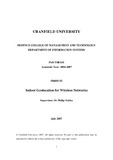JavaScript is disabled for your browser. Some features of this site may not work without it.
| dc.contributor.advisor | Nobles, P. | |
| dc.contributor.author | Ali, S. | |
| dc.date.accessioned | 2011-01-11T16:28:32Z | |
| dc.date.available | 2011-01-11T16:28:32Z | |
| dc.date.issued | 2011-01-11 | |
| dc.identifier.uri | http://dspace.lib.cranfield.ac.uk/handle/1826/4721 | |
| dc.description.abstract | An ever growing demand for ‘location based services’ and the unprecedented growth of wireless local area networks (WLAN) has, in the past few years, attracted the focus of the research community to investigate and develop accurate indoor geolocation systems. Performance of any geolocation system is based upon the reported distance error . The accuracy required varies from application to application. For example an accurate geolocation system is required to apprehend a rogue client (illegitimate connection) inside a building in a dense wireless environment. At present this is possible only through wireless radio frequency (RF) interception of signals. The received signal strength (RSS) of a signal can be used to report the position of a client by triangulation. The hostile indoor environment presents many challenges including multipath and wall attenuation that needs to be considered for determining accurate indoor location. In this thesis a novel method to reduce the variation in RSS values is demonstrated by exploiting the frequency diversity existing across multiple channels of devices equipped with the IEEE 802.11 a/b/g wifi (wireless fidelity) standards. Absorption of the RF signal due to walls is observed and identified as one of the major factors that influence location estimation. RSS from different directions and within different environments is also studied. The processed RSS values are then applied to location estimation using a novel RSS threshold algorithm based upon a RF propagation model. The algorithm is designed based on the room dimensions where location sensors are placed. The algorithm’s main feature is to correctly identify the walls existing between the sensors and client. Correct determination of walls together with a data fusion process produces accurate location results. For a set of example locations, the algorithm gives an accuracy of 3m for 75% of the locations and in terms of mean location error, is shown to be 2.16m for 100% of the locations. The reported accuracy is superior to the most accurate existing systems. The research trend for indoor geolocation has recently focused upon a ‘finger-printing’ technique, which is environment dependant and time consuming. The results achieved and presented in this thesis revive the use of simple propagation modelling for indoor geolocation applications. | en_UK |
| dc.language.iso | en | en_UK |
| dc.rights | © Cranfield University 2007. All rights reserved. No part of this publication may be reproduced without the written permission of the copyright owner. | en_UK |
| dc.title | Indoor geolocation for wireless networks | en_UK |
| dc.type | Thesis or dissertation | en_UK |
| dc.type.qualificationlevel | Doctoral | en_UK |
| dc.type.qualificationname | PhD | en_UK |
| dc.publisher.department | Department of Information Systems | en_UK |
